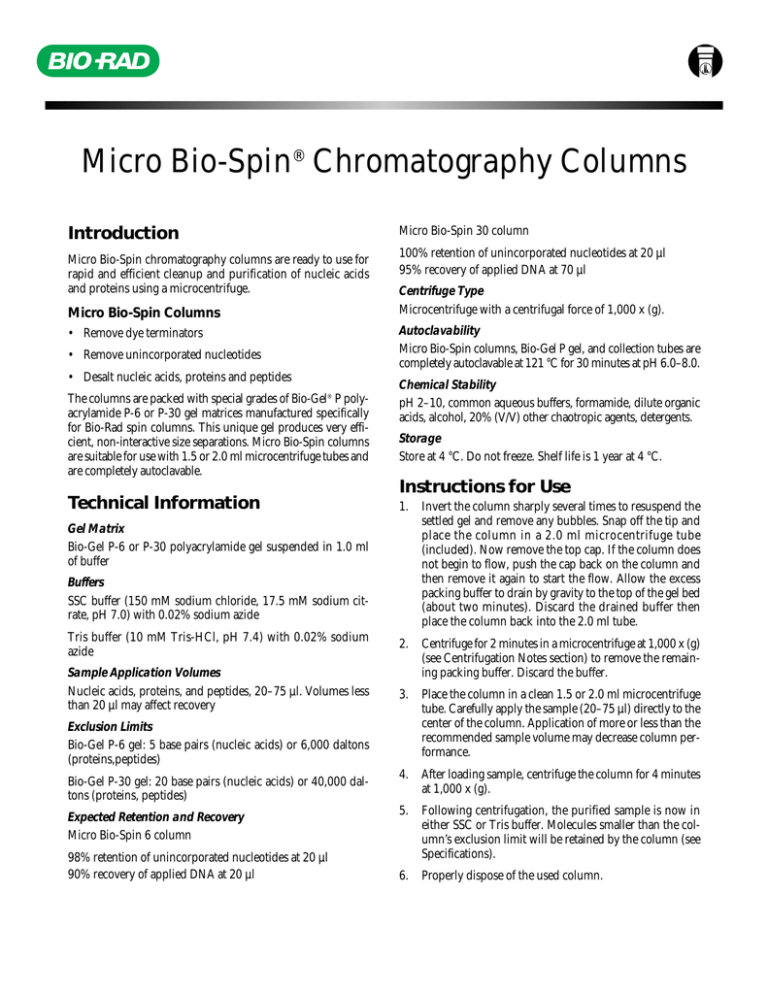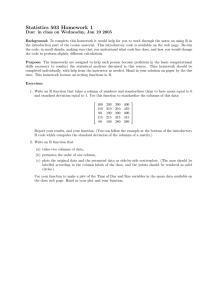Micro Bio-Spin® Chromatography Columns - Bio-Rad
advertisement

Micro Bio-Spin® Chromatography Columns Introduction Micro Bio-Spin chromatography columns are ready to use for rapid and efficient cleanup and purification of nucleic acids and proteins using a microcentrifuge. Micro Bio-Spin Columns • Remove dye terminators • Remove unincorporated nucleotides • Desalt nucleic acids, proteins and peptides The columns are packed with special grades of Bio-Gel® P polyacrylamide P-6 or P-30 gel matrices manufactured specifically for Bio-Rad spin columns. This unique gel produces very efficient, non-interactive size separations. Micro Bio-Spin columns are suitable for use with 1.5 or 2.0 ml microcentrifuge tubes and are completely autoclavable. Micro Bio-Spin 30 column 100% retention of unincorporated nucleotides at 20 µl 95% recovery of applied DNA at 70 µl Centrifuge Type Microcentrifuge with a centrifugal force of 1,000 x (g). Autoclavability Micro Bio-Spin columns, Bio-Gel P gel, and collection tubes are completely autoclavable at 121 °C for 30 minutes at pH 6.0–8.0. Chemical Stability pH 2–10, common aqueous buffers, formamide, dilute organic acids, alcohol, 20% (V/V) other chaotropic agents, detergents. Storage Store at 4 °C. Do not freeze. Shelf life is 1 year at 4 °C. Instructions for Use Technical Information 1. Invert the column sharply several times to resuspend the settled gel and remove any bubbles. Snap off the tip and place the column in a 2.0 ml microcentrifuge tube (included). Now remove the top cap. If the column does not begin to flow, push the cap back on the column and then remove it again to start the flow. Allow the excess packing buffer to drain by gravity to the top of the gel bed (about two minutes). Discard the drained buffer then place the column back into the 2.0 ml tube. Tris buffer (10 mM Tris-HCl, pH 7.4) with 0.02% sodium azide 2. Sample Application Volumes Nucleic acids, proteins, and peptides, 20–75 µl. Volumes less than 20 µl may affect recovery Centrifuge for 2 minutes in a microcentrifuge at 1,000 x (g) (see Centrifugation Notes section) to remove the remaining packing buffer. Discard the buffer. 3. Place the column in a clean 1.5 or 2.0 ml microcentrifuge tube. Carefully apply the sample (20–75 µl) directly to the center of the column. Application of more or less than the recommended sample volume may decrease column performance. 4. After loading sample, centrifuge the column for 4 minutes at 1,000 x (g). 5. Following centrifugation, the purified sample is now in either SSC or Tris buffer. Molecules smaller than the column’s exclusion limit will be retained by the column (see Specifications). 6. Properly dispose of the used column. Gel Matrix Bio-Gel P-6 or P-30 polyacrylamide gel suspended in 1.0 ml of buffer Buffers SSC buffer (150 mM sodium chloride, 17.5 mM sodium citrate, pH 7.0) with 0.02% sodium azide Exclusion Limits Bio-Gel P-6 gel: 5 base pairs (nucleic acids) or 6,000 daltons (proteins,peptides) Bio-Gel P-30 gel: 20 base pairs (nucleic acids) or 40,000 daltons (proteins, peptides) Expected Retention and Recovery Micro Bio-Spin 6 column 98% retention of unincorporated nucleotides at 20 µl 90% recovery of applied DNA at 20 µl Buffer Exchange The gel in the Micro Bio-Spin columns is suspended in either SSC buffer, pH 7.0, or Tris buffer, pH 7.4. The gel matrix is compatible with most aqueous buffers. Buffer exchange can be achieved using the following procedure. 1. Follow steps 1 and 2 in the Instructions for Use section. 2. Apply the new buffer in 500 µl aliquots. After each application of new buffer, let the buffer drain out by gravity, or centrifuge the column for 1 minute to remove the buffer. Discard buffer from collection tube. Repeat as required. Three washes result in > 99% of the buffer exchanged. Four washes result in > 99.9% of buffer exchanged. 3. Ordering Information Catalog Number Bio-Gel P-6 Columns in SSC 732-6200 Micro Bio-Spin 6 Column, SSC, 25, includes 25 P-6 columns in SSC buffer, 25 buffer collection tubes, and instruction manual 732-6201 Micro Bio-Spin 6 Column, SSC, 100, includes 100 P-6 columns in SSC buffer, 100 buffer collection tubes, and instruction manual 732-6205 Micro Bio-Spin 6 Column, SSC, 1,000, includes 1,000 P-6 columns in SSC buffer, 1,000 buffer collection tubes, and instruction manual Sample can now be applied to the column as directed in steps 3 through 6 in the Instructions for Use section. Centrifugation Notes Micro Bio-Spin columns fit 1.5 ml microcentrifuge tubes for sample collection during centrifugation. Use the 2.0 ml microtubes provided with the columns for the initial column equilibration step. Benchtop microcentrifuges capable of generating a minimum force of 1,000 x (g) are suitable for Micro Bio-Spin column use. The gravitational force created at a particular rpm is a function of the radius of the microcentrifuge rotor. Consult the microcentrifuge instruction manual for conversion information from rpm to g-force. Alternatively, to calculate the speed (rpm) required to reach a gravitational force of 1,000 x (g), use the following equation: Bio-Gel P-6 Columns in Tris 732-6221 Micro Bio-Spin 6 Column, Tris, 25, includes 25 P-6 columns in Tris buffer, 25 buffer collection tubes, and instruction manual 732-6222 Micro Bio-Spin 6 Column, Tris, 100, includes 100 P-6 columns in Tris buffer, 100 buffer collection tubes, and instruction manual 732-6225 Micro Bio-Spin 6 Column, Tris, 1,000, includes 1,000 P-6 columns in Tris buffer, 1,000 buffer collection tubes, and instruction manual Bio-Gel P-30 Columns in SSC 732-6202 Micro Bio-Spin 30 Column, SSC, 25, includes 25 P-30 columns in SSC buffer, 25 buffer collection tubes, and instruction manual 732-6203 Micro Bio-Spin 30 Column, SSC, 100, includes 100 P-30 columns in SSC buffer, 100 buffer collection tubes, and instruction manual 732-6206 Micro Bio-Spin 30 Column, SSC, 1,000, includes 1,000 P-30 columns in SSC buffer, 1,000 buffer collection tubes, and instruction manual RCF (g) = (1.12 x 10-5)(rpm)2r where r is the radius in centimeters measured from the center of the rotor to the middle of the Micro Bio-Spin column, and rpm is the speed of the rotor in revolutions per minute. Sample Dilution Troubleshooting Guide Sample dilution will occur if, during column equilibration, the column is centrifuged without first removing the excess packing buffer. Dilution will also occur if the excess packing buffer is left in the collection tube prior to centrifugation. The tip of the column becomes submerged and retains excess buffer. Product Description Bio-Gel P-30 Columns in Tris 732-6223 Micro Bio-Spin 30 Column, Tris, 25, includes 25 P-30 columns in Tris buffer, 25 buffer collection tubes, and instruction manual To correct this situation, always discard the buffer from the collection tube after gravity draining and after the first centrifugation (steps 1 and 2 of Instructions for Use section). 732-6224 Micro Bio-Spin 30 Column, Tris, 100, includes 100 P-30 columns in Tris buffer, 100 buffer collection tubes, and instruction manual Sterilization 732-6226 If a sterile Micro Bio-Spin column is required, autoclave the column at 121 °C for 20–30 minutes. If exchanging buffers, the buffer pH in the column should be in the range of 6.0 to 8.0 prior to autoclaving. Micro Bio-Spin 30 Column, Tris, 1,000, includes 1,000 P-30 columns in Tris buffer, 1,000 buffer collection tubes, and instruction manual Empty Columns 732-6204 Empty Micro Bio-Spin Column, 100, includes 100 empty columns, 100 buffer collection tubes, and instruction manual Bio-Rad Laboratories Life Science Group Bio-Rad Laboratories Main Office, 2000 Alfred Nobel Drive, Hercules, California 94547, Ph. (510) 741-1000, Fx. (510) 741-5800 Also in: Reagents Park, Australia, Ph. 02-9914-2800, Fx. 02-9914-2888 Wien, Austria, Ph. (1) 877 89 01, Fx. (1) 876 56 29 Nazareth, Belgium, Ph. 09-385 55 11, Fx. 09-385 65 54 Mississauga, Canada, Ph. (905) 712-2771, Fx. (905) 712-2990 Beijing, China, Ph. (01) 2046622, Fx. (01) 2051876 Copenhagen, Denmark, Ph. 39 17 9947, Fx. 39 27 1698 Espoo, Finland, Ph. 90 804 2200, Fx. 90 804 1100 Ivry sur Seine Cedex, France, Ph. (1) 49 60 68 34, Fx. (1) 46 71 24 67 München, Germany, Ph. 089 31884-0, Fx. 089 31884-100 New Delhi, India, Ph. 91-11-461-0103, Fx. 91-11-461-0765 Milano, Italy, Ph. 02-21609.1, Fx. 02-21609.399 Tokyo, Japan, Ph. 03-5811-6270 Fx. 03-5811-6272 Veenendaal, The Netherlands, Ph. 0318-540666, Fx. 0318-542216 Auckland, New Zealand, Ph. 09-443 3099, Fx. 09-443 3097 Kowloon, Hong Kong, Ph. 7893300, Fx. 7891257 Singapore, Ph. (65) 272-9877, Fx. (65) 273-4835 Solna, Sweden, Ph. 46 (0) 8 735 83 00, Fx 46 (0) 735 54 60 Madrid, Spain, Ph. (91) 661 70 85, Fx. (91) 661 96 98 Glattbrugg, Switzerland, Ph. 01/809 55 55, Fx. 01/809 55 00 Hemel Hempstead, United Kingdom, Ph. 0800 181134, Fx. 01442 259118 SIG 020996 Printed in USA 4006051 Rev B

